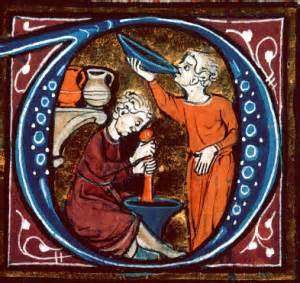

| Online: | |
| Visits: | |
| Stories: |

| Story Views | |
| Now: | |
| Last Hour: | |
| Last 24 Hours: | |
| Total: | |
The Human Body, Illness and Death in the Crusader Era
Saturday, February 18, 2017 18:06
% of readers think this story is Fact. Add your two cents.
The Human Body, Illness and Death in the Crusader Era
The Human Body, Illness and Death in the Crusader Era
In addition (VIDEO) Was Medieval Islam “More Advanced” than Christian Europe?
It is often assumed that the people who practiced medicine in the Middle Ages were ignorant, untrained, guided by “pure superstition” and accountable to no one. Today’s post, the first in a series of guest essays by German scholar Fermin Person,looks at medical practitioners and standards in the Crusader States.
The medieval concept of illness was different from our current understanding. In the medieval period, medical theory (common to bothEast and West) explained illness as an imbalance of the four humours (body fluids), as divine punishment, as astrology or as the working of evil entities.
These basic concepts existed parallel to each other and mixed to some degree during the medieval period. There already existed the notion of infectious diseases and of epidemics, but with the very limited diagnostic capabilities of the period (seeing, smelling, tasting, feeling), it was not possible to differentiate infectious diseases from auto-immune disease or poisoning.
|
Excurs: Bloodletting
Following the works of Galen bloodletting was practised extensively both in the western as well in the Islamic world since the antiquity. Bloodletting was used prophylactically in healthy persons as well as during illnesses. The statutes of the Templars and of the order of St John specified, for example, the possibilities and the treatment of members of the Orders that had been bloodlet. The laws of Outremer specifically demanded that a physician use bloodletting, if a patient was suffering from fever.
|
Ergotism (called “holy fire” or “St. Anthonies Fire”) for example, caused by alkaloids produced by fungus that befall cereals during wet weather, broke out in epidemics.
There was some understanding that blood loss from wounds was an important factor in the death from injuries, but there was still no understanding of the pathophysiology of haemorrhagic shock.
Another point of discussion was whether pus in wounds was something negative or positive. Medieval western (and Arabic) physicians lacked an understanding of infectious diseases and microbiology.
Similarly, the exact function of many organs was unknown or was misinterpreted, and the working of the circulatory system was also wrongly understood. For example, based on the classical scholar Galen, medieval physicians considered the liver to be the place of blood production.
|
Excurse: Galens teaching of Humours
Galenos of Pergamon (129/131 – 200/215 a.C.) was a Greco-Roman physician and anatomist. His works were translated into the Arabic language. He influenced heavily both western Christian, eastern roman and Arabic medicine. He applied the teaching of humors to medicine. According to him there were four body fluids blood, black bile, yellow bile and phlegm. If the four humors were in misbalance illnesses could result from that. Through diet, appropriate medication and bloodletting the body fluids could be brought into balance again.
|
If you enjoy the TradCatKnight blogs, please recommend above as a contributor!
Watch Video and Read more at link above!

The contributor has disabled comments for this story


